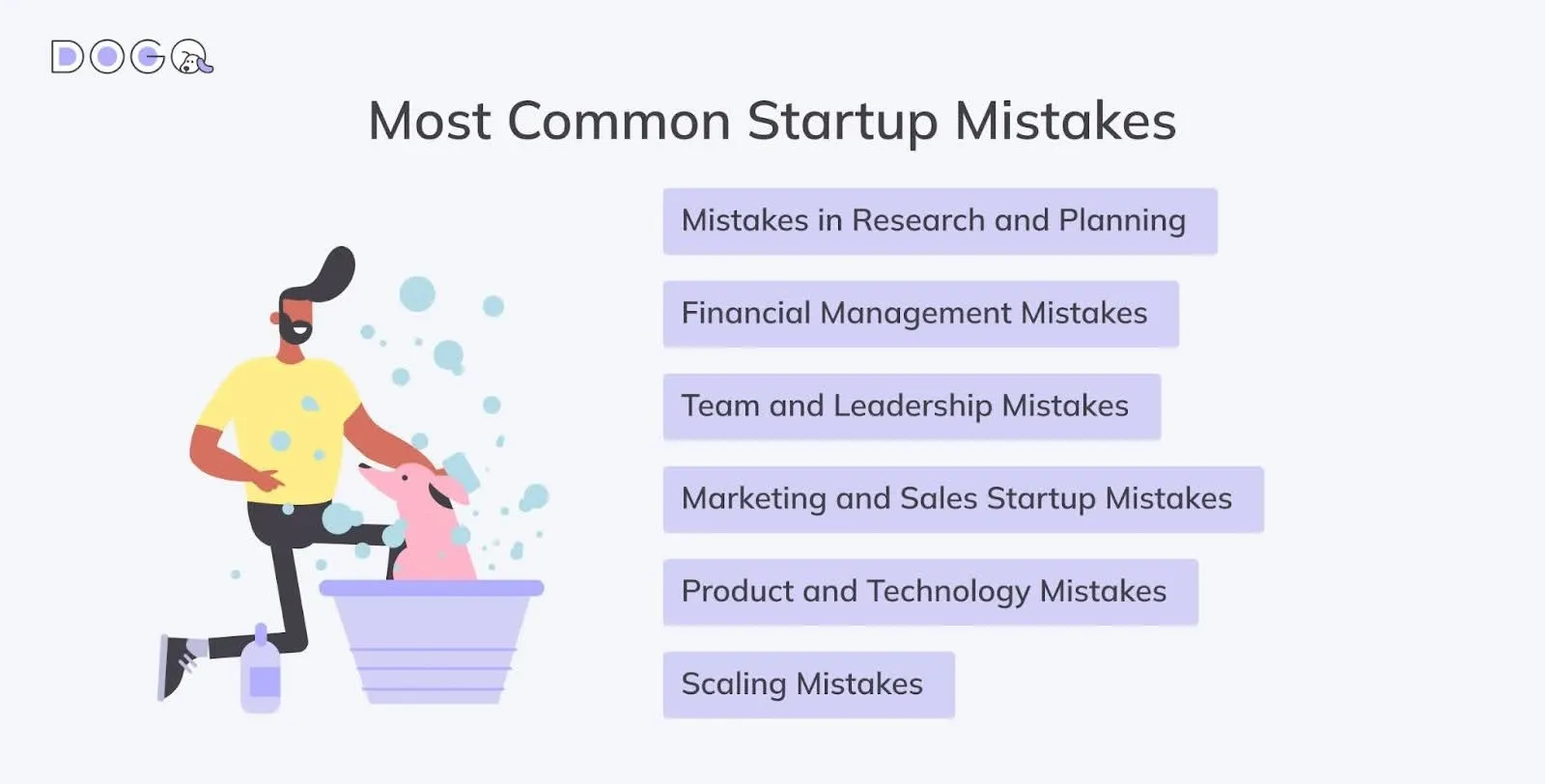19 Most Common Startup Mistakes and How to Avoid Them Like a Pro
Explore the most common startup mistakes, from poor financial management to scaling too early, and get actionable strategies to build a sustainable, high-growth business.
Starting a business is exciting, but let’s be real — most startups don’t make it past the first few years. The good news? Failure isn’t random. There are common mistakes that sink startups, and if you know what they are, you can avoid them before they happen.
From poor market research and bad financial planning to scaling too fast or ignoring customer feedback, these missteps can mean the difference between a thriving business and an expensive lesson. But don’t worry — we’ve got you covered!
In this article, we’ll break down the 19 biggest startup mistakes, why they happen, and — most importantly — how to dodge them and build a startup that lasts.
Ready? Let’s dive in!
Table of Contents
🔍 Mistakes in Research and Planning
💸 Financial Management Mistakes
👩💻👨💻 Team and Leadership Mistakes
✨ Marketing and Sales Startup Mistakes
⚙️ Product and Technology Mistakes
🦄 Scaling Mistakes
✔️ Wrapping Up: Avoid the Common Startup Mistakes, Build Smarter, and Scale Stronger

TL;DR: Common Startup Mistakes
Mistakes in Research and Planning: Skipping market research and having no solid business plan? You might end up with a product no one wants. Always do your homework and plan for at least 6-12 months of runway to avoid running out of money!
Financial Management Mistakes: Blowing cash on unnecessary perks or underestimating costs? Big mistake! Focus on product development, marketing, and sales first, and keep your budget tight until you’re profitable.
Team and Leadership Mistakes: Hiring the wrong fit or not defining roles? It leads to confusion and burnout. Build a team that gels well together, set clear roles, and lead with trust and transparency.
Marketing and Sales Mistakes: Not knowing your target audience? Your marketing efforts will miss the mark. Understand your audience, develop a strong brand, and set up a scalable sales strategy for growth.
Product and Technology Mistakes: Building a product without validating the idea? That’s risky. Test your ideas early, prioritize user experience, and stay adaptable to tech changes to keep your product fresh and valuable.
Scaling Mistakes: Scaling too fast without the right foundation? It’ll break you. Make sure your product-market fit is solid, operations are streamlined, and quality is maintained as you grow.
Mistakes in Research and Planning: Setting Yourself Up for Failure Before You Even Start
Lots of startups fail before they even launch — not because their idea is bad, but because they didn’t do their homework. Skipping market research or failing to create a solid business plan can lead to poor decisions, wasted money, and a product no one wants. Here are the biggest research and planning mistakes startups make.
1. Not Researching the Market
🚨 Why It’s a Mistake:
Many founders fall in love with an idea and assume there’s demand. But without data-driven market research, you’re essentially gambling. If you don’t validate your idea, you could end up building a product that no one actually needs.
✅ How to Avoid It:
- Conduct customer interviews, surveys, and competitor analysis.
- Use tools like Google Trends, Statista, and industry reports to understand market demand.
- Test the market with an MVP (Minimum Viable Product) before committing to full-scale development.
2. Failing to Create a Comprehensive Business Plan
🚨 Why It’s a Mistake:
A business plan isn’t just a formality — it’s your blueprint for success. Without a roadmap, you’ll struggle with funding, operations, and long-term growth. A lot of startups wing it, only to find themselves lost when challenges arise.
✅ How to Avoid It:
- Outline your business model, target market, and revenue streams.
- Define short-term and long-term goals with clear milestones.
- Factor in budgeting and marketing strategies from day one.
3. Underestimating Costs and Cash Flow Needs
🚨 Why It’s a Mistake:
Numerous startups burn through cash too quickly because they underestimate expenses or assume revenue will start flowing sooner than it actually does. Running out of money is one of the top reasons startups fail.
✅ How to Avoid It:
- Break down all expected costs, including marketing, salaries, and product development.
- Have at least 6-12 months of runway before scaling operations.
- Secure multiple funding sources (bootstrapping, investors, grants) instead of relying on one.
➡️ Jump back to Table of Contents
🔥 Check out our latest blog post: “The Ultimate Toolkit for Founders: Best Startup Tools in 2025”
Financial Management Mistakes: How Startups Burn Through Cash and Go Broke
Money is the lifeline of any startup, and poor financial management is one of the fastest ways to fail. Many founders either spend too much on the wrong things, underestimate costs, or fail to manage cash flow properly — all of which can lead to burnout, funding shortages, and eventual collapse.
1. Spending Money on the Wrong Things
🚨 Why It’s a Mistake:
New founders often waste money on things that don’t drive real business growth — fancy offices, high-end branding, or unnecessary perks. While these might look good, they don’t necessarily bring in revenue.
✅ How to Avoid It:
- Prioritize essential spending — product development, marketing, and sales.
- Opt for lean operations — use coworking spaces, open-source software, and freelancers instead of full-time hires early on.
- Only invest in branding and infrastructure once you have a proven product and paying customers.
2. Underestimating Financial Needs
🚨 Why It’s a Mistake:
A great number of startups assume they’ll start generating revenue quickly, but the reality is that most take much longer than expected to become profitable. Without proper financial planning, startups run out of money before they gain traction.
✅ How to Avoid It:
- Plan for at least 12-18 months of runway, factoring in worst-case scenarios.
- Include hidden costs like legal fees, software licenses, and unexpected expenses.
- Secure multiple funding options (bootstrapping, grants, angel investors, venture capital) instead of relying on one.
3. Poor Cash Flow Management
🚨 Why It’s a Mistake:
Even if your startup is making money, cash flow issues can still kill your business. Late payments, high burn rates, and bad budgeting can leave you unable to pay employees, suppliers, or essential expenses.
✅ How to Avoid It:
- Track income and expenses with tools like QuickBooks, Xero, or FreshBooks.
- Use a cash flow forecast to predict potential shortfalls and adjust spending accordingly.
- Set payment terms with clients to ensure timely revenue collection.
➡️ Jump back to Table of Contents
Team and Leadership Mistakes: The Wrong People Will Sink Your Startup Faster Than a Bad Idea
Your team is your biggest asset — or your biggest liability. Numerous startups fail not because of bad products, but because of bad hiring, poor leadership, and a lack of clear team structure. A strong team can turn an average idea into a billion-dollar company, while a weak team can destroy even the most promising startup. Here’s how to avoid common team and leadership mistakes.
1. Hiring People You Won’t Want to Rehire
🚨 Why It’s a Mistake:
In the rush to build a team, a lot of startups hire the wrong people — friends, cheap freelancers, or anyone who seems remotely qualified. But hiring the wrong talent leads to low productivity, poor execution, and toxic work environments.
✅ How to Avoid It:
- Hire for skills AND culture fit — look for people who believe in your vision, not just those with impressive resumes.
- Test before committing — start with small contracts or trial projects before making full-time hires.
- Don’t settle — it’s better to be understaffed than to hire someone who slows you down.
2. Unclear Team Roles and Responsibilities
🚨 Why It’s a Mistake:
If no one knows who’s responsible for what, work gets duplicated, crucial tasks get ignored, and conflicts arise. Numerous startups assume people will just “figure it out”, but the lack of role clarity leads to missed deadlines, inefficiency, and team frustration.
✅ How to Avoid It:
- Clearly define roles, responsibilities, and accountability for each team member.
- Use project management tools (Trello, Asana, Notion) to track tasks and ownership.
- Set measurable goals for each team member and hold them accountable.
3. Ineffective Leadership
🚨 Why It’s a Mistake:
Many startup founders are great at product development but terrible at leadership. Poor leadership leads to low morale, high turnover, and lack of direction. If your team doesn’t trust your leadership, your startup won’t survive.
✅ How to Avoid It:
- Learn to delegate — micromanaging kills productivity.
- Be transparent — keep your team informed about challenges and wins.
- Lead by example — work ethic and company culture start at the top.
➡️ Jump back to Table of Contents
Marketing and Sales Startup Mistakes: The Fastest Way to Lose Customers and Revenue in 2025
Even the best product won’t sell itself. Many startups fail because they neglect marketing, ignore customer feedback, or price their product incorrectly. A great idea and a great team won’t matter if no one knows about your product or wants to buy it. Here’s how to avoid common marketing and sales mistakes.
1. Not Creating a Marketing Plan
🚨 Why It’s a Mistake:
Too many startups launch without a clear marketing strategy, assuming that word-of-mouth or social media alone will be enough. Without a plan, they struggle to reach the right audience, generate leads, and convert users into customers.
✅ How to Avoid It:
- Define your ideal customer profile (ICP) — who needs your product and why?
- Choose the right marketing channels — SEO, paid ads, social media, email, partnerships, etc.
- Set clear goals and track performance — use KPIs to measure marketing effectiveness.
2. Disregarding Customer Feedback
🚨 Why It’s a Mistake:
Lots of startups assume they know what customers want instead of actually listening to them. Ignoring feedback leads to product-market misalignment, wasted development resources, and low user retention.
✅ How to Avoid It:
- Talk to your customers — conduct surveys, user interviews, and beta tests.
- Analyze churn reasons — why are customers leaving, and what can you fix?
- Continuously iterate based on feedback — your first product version won’t be perfect.
3. Pricing Products Improperly
🚨 Why It’s a Mistake:
Startups often undervalue or overprice their product, either scaring away potential customers or leaving money on the table. Pricing is more than guesswork — it’s a strategy.
✅ How to Avoid It:
- Research competitor pricing and position yourself strategically.
- Test different pricing models — freemium, subscription, one-time payment.
- Adjust pricing based on customer perception, value, and market demand.
➡️ Jump back to Table of Contents
🔥 Check out our latest blog post: “The Ultimate Toolkit for Founders: Best Startup Tools in 2025”
Product and Technology Mistakes: Building the Wrong Way Can Kill Your Startup
A great idea is great, but it isn’t enough — how you build your product matters just as much as what you build. Many startups fail because they invest in too many tools, launch before they’re ready, or neglect testing. These mistakes lead to technical debt, user frustration, and wasted resources. Here’s how to avoid them.
1. Investing in Too Many Software Products
🚨 Why It’s a Mistake:
Startups often fall into the “shiny object syndrome”, spending money on every new tool and software they think will improve efficiency. Instead, they end up with overcomplicated workflows, unnecessary expenses, and bloated tech stacks.
✅ How to Avoid It:
- Prioritize essential tools — only invest in software that directly improves development, collaboration, or customer acquisition.
- Use free or open-source alternatives when possible.
- Regularly audit your tech stack to remove redundant tools.
2. Launching Too Early
🚨 Why It’s a Mistake:
Many founders rush to launch without validating their product, resulting in buggy, incomplete, or non-user-friendly software. A bad first impression can lead to high churn rates and lost credibility.
✅ How to Avoid It:
- Develop a Minimum Viable Product (MVP) first — launch with just enough features to test market demand.
- Gather real user feedback before scaling.
- Fix critical bugs and usability issues before the official launch.
3. Ignoring Test Automation
🚨 Why It’s a Mistake:
Skipping test automation leads to undetected bugs, poor performance, and higher development costs in the long run. A big number of startups rely only on manual testing, which is slow and error-prone.
✅ How to Avoid It:
- Implement automated testing early — including unit tests, regression tests, and performance testing.
- Use tools like DogQ, Selenium, or Jest to streamline testing.
- Adopt CI/CD pipelines to catch and fix bugs before they reach users.
For example, no-code automation testing with DogQ allows teams to easily create and run tests without needing deep coding expertise, making it ideal for fast-moving startups that need efficiency without complexity.

By integrating DogQ, startups can eliminate manual testing bottlenecks, speed up development cycles, and maintain high product quality with minimal effort — ensuring they launch with confidence and scale without disruptions.
➡️ Jump back to Table of Contents
Scaling Mistakes: Growing Too Fast or in the Wrong Direction Can Kill Your Startup
Scaling is a double-edged sword — do it too soon, and you risk burning through cash and resources. Do it too late, and you might miss out on market opportunities. Many startups fail because they hire too quickly, expand without a strategy, or neglect their core product while chasing growth. Here’s how to avoid these common mistakes.
1. Scaling Too Early
🚨 Why It’s a Mistake:
Some startups assume early traction equals long-term success, so they hire aggressively, expand operations, and spend heavily on marketing before securing a stable customer base. This leads to high burn rates, inefficiencies, and, in many cases, a rapid downfall.
✅ How to Avoid It:
- Scale only when you have repeatable, predictable revenue.
- Ensure your product-market fit is validated before investing in aggressive expansion.
- Grow your team and operations gradually, based on actual demand — not assumptions.
2. Ignoring Operational Bottlenecks
🚨 Why It’s a Mistake:
Expanding without addressing internal inefficiencies can lead to chaotic workflows, missed deadlines, and poor customer experiences. If your systems, processes, and infrastructure aren’t built for scale, your growth will break the business rather than elevate it.
✅ How to Avoid It:
- Automate manual processes upfirst.
- Invest in scalable infrastructure — whether it’s cloud services, team structures, or customer support.
- Improve internal communication and workflow management to prevent breakdowns.
3. Expanding the Team Too Quickly
🚨 Why It’s a Mistake:
Hiring too many people before the business can support them results in higher payroll costs, diluted company culture, and inefficiencies. A lot of startups overhire in anticipation of growth and end up downsizing later, which damages morale and reputation.
✅ How to Avoid It:
- Hire based on actual workload, not projected needs.
- Focus on key hires that will have the most impact on growth.
- Consider outsourcing or contract workers before committing to full-time hires.
4. Losing Focus on Core Product and Customers
🚨 Why It’s a Mistake:
Many startups get caught up in expansion — new markets, new features, new customer segments — while neglecting their core product and early adopters. This often leads to poor customer retention and a diluted brand identity.
✅ How to Avoid It:
- Prioritize customer satisfaction and retention before expanding.
- Focus on refining and perfecting your existing product before adding new ones.
- Use customer feedback to guide product and business growth.
➡️ Jump back to Table of Contents

🔥 Check out our latest blog post: “The Ultimate Toolkit for Founders: Best Startup Tools in 2025”
Wrapping Up: Avoid the Common Startup Mistakes, Build Smarter, and Scale Stronger
Starting a business is tough — but failing for avoidable reasons is even tougher. The reality is, most startups don’t crash because of bad ideas — they crash because of bad execution. From skipping market research and burning through cash to hiring the wrong people, these mistakes can kill even the most promising venture.
But here’s the good news: Every mistake on this list is avoidable.
✅ Do your homework — research the market, validate your idea, and plan your finances wisely.
✅ Build with purpose — prioritize product quality, test rigorously, and listen to your customers.
✅ Scale strategically — grow when the numbers prove you’re ready, not just because it feels like the next step.
✅ Invest in the right team — hire people who align with your vision, not just those who fill a role.
One crucial part of execution that many startups overlook is software quality assurance. Releasing a buggy, unstable product can destroy user trust and slow down growth. That’s why automated testing is essential — and that’s where DogQ, a powerful no-code testing tool, comes in.
With DogQ, startups can automate software testing without writing a single line of code, ensuring a seamless user experience while saving time, resources, and development costs. No more manual testing headaches or surprise bugs at launch — just a streamlined, reliable way to maintain top-tier product quality from day one.

Your startup’s success is about learning fast, fixing mistakes, and making smart moves before they cost you everything.
It’s time to build something great — with the right strategy, the right team, and the right tools like DogQ to support your journey!
Related posts:
An Ultimate User Interface Testing Guide + UI Testing Checklist. We All Like to Talk About Seamless User Experience
End to End Testing Guide for 2025. Learn Best Practices for Broader Coverage
How to Build a Successful Testing Team? How to Increase and Maintain Team Motivation? Get a super-detailed guide.
SaaS Testing: Challenges, Best Practices and Testing Checklists. Find out best practices for effective SaaS test automation, successfully overcome its challenges, and ensure high quality at speed.
6 Essential Skills You Need to Become a No-Code QA Specialist. Read the article to explore all the necessary skills of a top no-code QA engineer and the essence of Quality Assurance.
